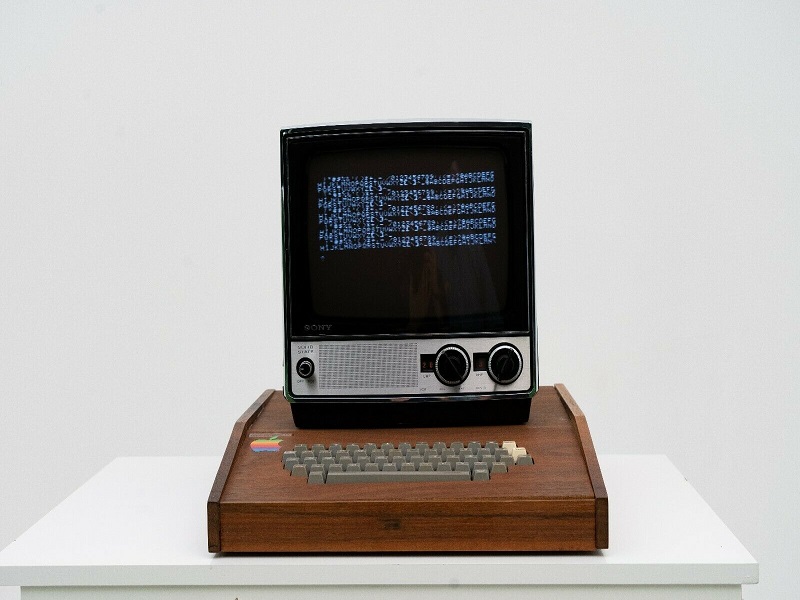In the ever-evolving tapestry of technology, there remain a few legends that not only shape the narrative but also redefine its trajectory. One such legend is the Apple 1 Computer. This pioneer of personal computing didn’t just mark the birth of Apple 1nc. but ignited a revolution that forever altered the technology landscape.
Setting the Stage: The Tech World of the 1970s
The 1970s was a decade of disco, bell bottoms, and most notably, a nascent digital revolution. While mainframes and punch cards were predominant, the vision of personal computing was still a distant dream for many. Enter Apple, with a vision distinct from the rest. Their aspiration wasn’t just to create a computer but to redesign the user experience.
Apple 1 Computer Price And Details
The dawn of Apple’s revolutionary journey began on April 11, 1976, with the introduction of the Apple-1. As a symbol of the cutting-edge technology of its time, this machine was priced at a unique $666.66. Making its debut in the heart of Silicon Valley, the first 50 units were quickly snapped up by enthusiasts and tech aficionados at The Byte Shop located in Mountain View, California.
But the Apple-1 wasn’t just about limited releases and early adopters. While initially, only 200 of these machines graced the market, Apple ensured the device’s legacy continued. Until September 1, 1977, those eager to own a piece of history could purchase the Apple-1, albeit at a reduced price of $475.
Key Specifications:
- Launch Date: April 11, 1976
- End of Production: September 1, 1977
- Initial Price: $666.66
- Weight: 5.3 lbs. (Approximately 2.400 KG)
- Dimensions: 15.5” W x 9” D or 39.37 cm W x 22.86 cm D
Where You Can See the Apple-1 Computer in Person
The Apple Computer 1 has now become a rarity in the realm of technology. With most of the last working units either showcased in museums or nestled within private collections, witnessing this marvel has become a unique experience. Because so many Apple 1 computers are either non-functional or kept away from public view, only a handful of venues around the world let enthusiasts and curious minds view a working unit.

Source: ign.com
Geographically, this iconic computer graces locations spanning from the United States to Australia, touching shores in South Korea, the UAE, Poland, Germany, and Great Britain.
Replica of Apple Computer 1 Source: applemuzeumpolska.pl – Replica of Apple Computer 1
For those itching to witness history firsthand, here’s where you can set your sights on the Apple Computer 1:
- National Museum of American History in Washington DC
- Computer History Museum in Mountain View, California
- American Computer & Robotics Museum in Bozeman, Montana
- Computer Museum of America in Roswell, Georgia
- Living Computers: Museum + Labs in Seattle, Washington
- System Source Computer Museum in Hunt Valley, Maryland
- MAAS Museum in Sydney, Australia
- Heinz Nixdorf MuseumsForum in Paderborn, Germany
- Deutsches Museum in Munich, Germany
- Science Museum in London, United Kingdom
- Nexon Computer Museum in Jeju Island, South Korea
- Appl Collection in Dubai, United Arab Emirates (Private)
- Apple Museum Poland in Warsaw, Poland (Replica)
The Brain Behind the Machine: Apple 1’s Tech Specs
Processor Insights
The Apple 1 came equipped with the MOS Technology 6502, a microprocessor that was both affordable and efficient. With a groundbreaking speed of 1 MHz, it might seem modest by today’s standards, but back then, it was revolutionary. The 8-bit architecture, though now archaic, was then a symbol of innovative tech, bridging the gap between complex computations and consumer affordability. The single-core design, while limiting multitasking, ensured that the primary tasks ran smoothly and efficiently.
Memory & Storage Innovations
The 4 KB built-in memory of the Apple 1 was a testament to Apple’s dedication to providing a holistic computing experience. While 4 KB seems minuscule now, in the context of the 1970s, it was a giant leap toward making computers accessible to the masses. The potential of expanding this memory up to 65 KB, combined with a 1 KB graphics memory, ensured users could run basic applications and even indulge in rudimentary gaming.
Connectivity & Display Dynamics
Connectivity was another domain where Apple 1 set benchmarks. The composite positive video display connection allowed users to connect their machines to household TVs, democratizing computer displays. Further, the Dual In-line Package (DIP) made user interaction intuitive, opening the door to a more engaged computing experience.
Expanding the Realm: Ports and Media Interfaces
The 44-pin expansion connector on the Apple 1 hinted at Apple’s vision of a modular and expandable system. The Cassette Board connector, though rudimentary, was an early nod to data storage and transfer. With the Apple 1nteger BASIC software, users had a platform to code, compute, and create, even if in a limited capacity.
Beyond the Specs: The Apple 1’s Industry Impact
The launch of Apple 1 was not just about introducing a new product but ushering in a new era of personal computing. No longer were computers the exclusive domain of scientists and elites. Apple 1 was a beacon, signaling the dawn of accessible computing. The firsthand accounts of users from the 1970s often resonate with awe and wonder, as they recount their experiences with this groundbreaking machine. The Apple 1 was not just a product but a phenomenon, setting the stage for the series of innovations Apple would introduce in the decades to follow.
A Collector’s Gem: Apple 1 in the Modern Era
In an age where technology evolves with astonishing speed, and devices become obsolete almost overnight, the Apple 1 stands defiantly, not just as a symbol of innovation’s past, but as a coveted piece of history. Its rarity and historical significance have elevated its status to one of the tech world’s most desired collectibles.
A Recent Auction Marvel
Recently, a fully functional Apple-1 computer, which bore the hand-numbered mark of none other than Apple co-founder Steve Jobs, was auctioned off for an impressive $442,118. This sale exceeded its anticipated estimate, which stood at $375,000.
The Rarity of Apple-1
This particular machine, labeled Apple-1 #78, is one of the only 200 units ever produced by the iconic duo of Steve Jobs and Steve Wozniak in 1976. The scarcity of these units further elevates their allure; it’s believed that of the original 200, only 60 to 70 remain in existence today.
Revival of a Legend
The auctioned Apple-1 wasn’t just a dormant relic. Brought back to life in 2018 by Apple specialist Corey Cohen, this functional piece of history also came with an authenticity letter, verifying Steve Jobs’ handwriting on the board. The package further included the original Apple Cassette Interface, an operational manual from the era, a surplus ASCII keyboard from the corresponding time frame, and a vintage open-frame Sanyo 4205 monitor.
The Price of History
While $442,118 is indeed a princely sum, certain Apple-1 computers have commanded even loftier prices at auction. The record is held by the “Celebration” Apple-1, which fetched a staggering $815,000.
Beyond the Apple-1 Computer
The recent auction wasn’t solely about the Apple-1. A Steve Jobs-autographed NeXT brochure went for $18,210, an early 1988 NeXT computer fetched $6,094, and a Tim Cook-signed football from Auburn University secured a bid of $5,681.
The Legacy Lives On
Today, in an era dominated by sophisticated devices, the Apple 1 remains a testament to humble beginnings. To tech aficionados and Apple enthusiasts, securing an original Apple 1 is akin to finding the Holy Grail. While auction houses see sky-high bids, the true value of the Apple 1 lies in its historical significance, reminding us of a garage-born dream that indeed changed the world.
Conclusion
The Apple 1 wasn’t just a product; it was a proclamation of possibilities, a testament to the power of vision, innovation, and sheer tenacity. Beyond its technical specifications and historical significance, it symbolized the birth of a dream that would change the face of technology and communication as we knew it.
To sum it all up, April 11th, 1976, stands as a monumental day in the annals of technological history. It’s not just about the birth of a product; it’s about the genesis of a company that would challenge norms, redefine industries, and usher in an era of unparalleled innovation. The Apple 1 wasn’t just a computer; it was a beacon of hope for every entrepreneur and every dreamer who believed in the transformative power of ideas. It showcased what was possible when vision met determination.
Today, as we gaze upon the labyrinthine tapestry of tech evolution, that modest Apple 1 unit reminds us of a starting point — of two young men in a garage, undeterred by the enormity of their dream. Apple’s journey from that garage to becoming one of the world’s most influential tech giants serves as a beacon of inspiration. It reminds us that with passion, perseverance, and innovative thinking, boundaries can be pushed, conventions can be challenged, and history can be made.
